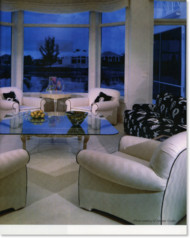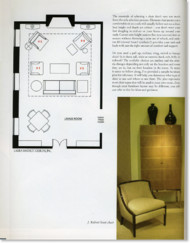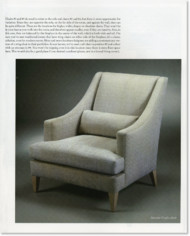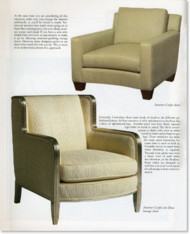Choosing the Perfect Chair
by Laura Barnett Designs | Choosing the Perfect Chair TCW

CLICK TO SEE IMAGE

CLICK TO SEE IMAGE

CLICK TO SEE IMAGE

CLICK TO SEE IMAGE

CLICK TO SEE IMAGE

CLICK TO SEE IMAGE

CLICK TO SEE IMAGE

CLICK TO SEE IMAGE

CLICK TO SEE IMAGE
In January, our TCW feature provided a variety of information to help you select the perfect sofa. This month we’re continuing the quest to furnish your family or living room by focusing on the chairs that will work perfectly with it. You have already determined the basic styling of your room when choosing your sofa, and since each decision you make limits your choices for the next item; it gets progressively easier to make selections as you go along. Sometimes you have to look a little harder to find just what you need, but it is well worth the effort. If you let these few principles guide you, you’ll know it when you see it. Coordinating sofa and chair details balances the room, and balance translates into beauty and comfort.
The essentials of selecting a chair don’t vary too much from the sofa selection process. Elements that assure you a comfortable sit on a sofa will usually follow suit on a chair. Seat height and depth are critical—you don’t want your feet dangling in mid-air or your knees up around your neck. Correct arm height assures that you can read, knit, or snooze without throwing a joint out of whack, and cushion fill (down? foam? synthetic?) provides your tushy and back with just the right amount of comfort and support.
Do you need a pull up, recliner, wing, swivel, or lounge chair? Is it short, tall, wide, or narrow; hard, soft, frilly, or tailored? The available choices are endless and the criteria changes depending not only on the function and room they are in, but on their location in the room. To make it easier to follow along, I’ve provided a sample furniture plan for reference. It will help you determine what type of chair to use and where to use them. The plan represents most chair types that will be used in your own room. Even though your furniture layout may be different, you still can refer to this for ideas and guidance.
If your chairs flank the sofa on either side they could be a pair of chairs that are exactly the same or two different chairs with similar attributes. Either way, their dimensions need to relate directly to each other and the sofa in order to maintain equilibrium in the space. If the chairs are identical, the fabric should be identical. This is usually the case in contemporary rooms, but also works for traditional settings. If the chairs are not a “true pair”, but are only similar, feel free to select a different fabric for each. Think harmony and balance unless you want all the attention to go to one particular piece.
Your sofa may have slim arms, cushions, or legs and sit low to the ground, or it may be chubby and have a high back and arms, but whichever it is, chairs near the sofa should follow suit. Shop with your trusty tape measure so you can check out the dimensions as you go along. The chair and sofa measures don’t have to be exactly the same, but they should be close. If your chair has a 15” seat height, it will look ridiculous next to sofa with a 19” seat height. Not only will the furniture look unbalanced, but the people sitting in it will feel off-kilter when they are seated at such different levels. While I prefer the seat heights to be the same, you can probably be within an inch and still be fine. The same is true for the arm and back heights. If either the seat and arm heights or the seat and back heights relate to one another, it gives you more latitude for the other dimension. For instance, if the seat height and the arm height of a sofa and chair are the same, you can usually introduce a chair with either a higher or lower back height.
Choosing the overall back height of your chairs depends on two factors. One is the relation of the height to the pieces of furniture near them; the other is the location of the chairs in the room. In our sample floor plan, the chairs are not up against a wall, but float in the space so you can approach them from all sides. To avoid a barricade of furniture in the middle of the room, this “floating” location dictates a lower back height, which would hold true of the sofa shown in this floor plan, as well. If you can look over the furniture in the foreground to the furniture, art, or architectural features at the back of the room, you are subconsciously invited and drawn into the space.
Heights and fabric are not enough to assure that the chairs and sofa will look good together. Consider the scale of the details when looking for compatible mates. An overstuffed sofa calls for a chair with some meat on its bones. Thicker cushions, wider arms, and stout legs are probably in order. Save the spindly chairs for the sofas with narrow arms and slim legs. If you pair them with a chubby sofa, they will look fragile and uncomfortable by comparison.
These chairs do need to relate to the sofa and the previous chairs, but there is more opportunity for variation. Since they are opposite the sofa, on the far side of the room, and against the wall, they can be quite different. These are the locations for higher, wider, deeper, or chunkier chairs. They won’t be in your face as you walk into the room, and therefore appear smaller, even if they are massive. Also, in this case, they are balanced by the fireplace in the center of the wall, which is both wide and tall. I’m sure you’ve seen traditional rooms that have wing chairs on either side of the fireplace; it’s a classic solution, even for modern rooms. More and more furniture designers are adding a contemporary version of a wing chair to their portfolios. In our layout, we’ve used a tall chair in position #3 and a chair with an ottoman in #4. You won’t be tripping over it in this location since there is extra floor space here. This would also be a good place if you desired a recliner (please, not in a formal living room!).
At the same time you are considering all this sameness, make sure you change the features sufficiently or you’ll be bored to death. Traditional interiors have much more going on in them than contemporary, but even sleek, modern rooms need detail. If you have a sofa with simple lines, you have an opportunity to shake it up by choosing attention-grabbing lounge chairs. However, many designers prefer to use chairs that match the sofa exactly. This is more of an architectural, almost Zen, approach.
Generally, I introduce three basic levels of detail to the different upholstered pieces. At least one piece is fully upholstered to the floor, has a skirt, or upholstered legs. Another piece may have short, exposed legs either in wood or metal. The third consideration is chairs with arms in either wood or metal and perhaps, longer legs. These variations can make the room more interesting because there is more to look at. Consider swivel or caster bases when flexibility is required. You and your guests may want a better view of each other, the television, or the fireplace. Some chairs are designed so well that you won’t even know the advantage is there until you need it.
Henry David Thoreau promoted simple living in natural surroundings and only had three chairs in his house. “….one for solitude, two for company, three for society.” Whether you have three chairs or many more, being careful in the selection process will make it look and feel like it all belongs together. There is no one solution; for it always depends upon personal preference and what else is happening in the room. The ultimate goal is to create a beautiful place to come home to. Even Thoreau would agree.
The sofa, chairs, tables, lamps, artwork, wall, window and floor treatments all play into the final result, so watch for our next installment in May as we add the next element to your room—the tables.
For further info about furniture in the pix:
Baker: Heather.Wiroll@kohler.com
Interior Crafts: Emily Ursini eursini@interiorcraftsinc.com
J. Robert Scott: June Triolo jtr1010@jrobertscott.com
All showrooms are at the Merchandise Mart, but their pr departments are off-site
Also, on the contributor’s page, my paragraph needs to change—I just stepped down from the presidency of Parkways Foundation. I remain on the board as Immediate Past President.
Click below to download PDF of entire article.
